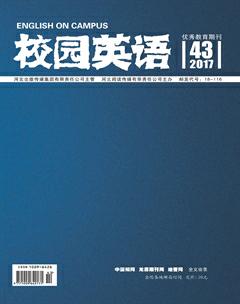Usage Differences of because between Chinese English Learners and Native Speakers
申彤
【Abstract】This study explores the usage differences of because between Chinese English learners and native speakers based on corpus. Results show:(1) the colligations of because in Chinese learner English and native speaker manifest similarity, but the usage of two patterns differ markedly;(2) the because-clauses in Chinese learner English precede the main sentence significantly more often than that in native English, which might be affected by language transfer.
【Key words】because; colligation; clause order; language transfer
1. Introduction
Causal relationship expression is a common phenomenon in language use. Because, for, since, as are the top four causal conjunctions in English (Fang & Kennedy 1992). Because is also frequently used by Chinese English learners. This study is to investigate the usage differences of because between Chinese English learners and native speakers. Previous studies mainly concern about the distributions of because-clauses (Wang 2010). This study observes the colligations of because in Chinese learner English and native English to find usage differences.
2. Research Question and Method
The research questions are:(1) what colligations of because are in Chinese learner English and native English respectively;(2) how because-clauses are distributed in Chinese leaners English and native English;(3) whether the distribution in Chinese learner English is influenced by language transfer.
This study is based on Chinese learner English Corpus (CLEC), Freiburg-LOB Corpus of British English (FLOB) and Center for Chinese Linguistics PKU (CCL). It randomly selects 200 concordances from FLOB and CLEC respectively with because as the node word, and 200 concordances from CCL with yinwei(因為)and youyu (由于) as the node word. The colligations of because and distributions of because-clause in FLOB and CLEC are compared to observe the usage differences between Chinese leaners and native speakers. In addition, its distribution in CCL is observed to see whether there is language transfer in Chinese learner English.
3. Results and Discussion
In FLOB the frequency of because is 778 and its normalized frequency count (per million) is 648.5, while in CLEC the frequency is 1875 and its normalized frequency count (per million) is 1524.8. The frequency of because in CLEC is much higher than that in FLOB, which shows that Chinese English learners tend to overuse because in writing.
Results show that the colligations of because in Chinese learner English and native English manifest five shared patterns:“because + causal clause”, “because of”, “It is/ This is + because”, “independent sentence” and “response to Why sentence”. Nevertheless, the amount of two patterns“It is/ This is + because” and “independent sentence” are significantly different. Compared with native speakers, Chinese English learners use the structure“It is/ This is + because” less, perhaps due to the deficiency of grammar knowledge. The independent uses of “because + sentence” in Chinese leaners English are much more than that of native speakers. Furthermore, all of the independent usage patterns in FLOB occur in conversations which is informal, while such patterns in CLEC are used in formal articles.
As seen from the results, “because + causal clauses” is the most frequently used pattern in both FLOB (68.5%) and CLEC (61.0%). Therefore, this study observes the distributions of because-clauses in FLOB and CLEC. It shows that in FLOB there are 11.76% at the initial position and 88.24% at the final position, while in CLEC 26.23% at the initial position and 73.77% at the final. A 2*2 X2-analysis reveals a significant association between language user and the distribution of because-causal clause [X2=8.886, df=1, p=0.003 (p<0.05)], suggesting because-clauses in Chinese learner English precede the main sentence significantly more often than that of native English.
In addition, the distributions of Chinese causal clauses introduced by yinwei and youyu in CCL are observed. Results show that there are 66.41% of causal clauses in CCL are at the initial position and 33.59% at the final. It suggests Chinese causal clauses tend to precede the main sentence. Therefore, the distribution of because-clauses in Chinese leaners English might be influenced by language transfer.
4. Conclusion
This study investigates usage differences of because between Chinese English learners and native speakers. It provides suggestions for English teaching and learning. Students should be aware that its inappropriate to use because in an independent sentence in formal writing, and because-clauses tend to follow the main clause.
References:
[1]Fang,X&Graeme,K.Expressing causation in written English.RELC Journal,1992(23):62-80.

